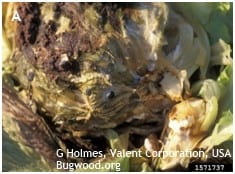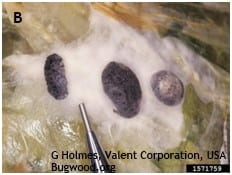Kate Everts, Vegetable Pathologist, University of Delaware and University of Maryland; keverts@umd.edu
Cool moist weather is conducive to the development of lettuce drop caused by Sclerotinia sclerotiorum and S. minor. The disease produces wet rot or watery decay at the base of plants. Small black irregular sclerotia are often present on the affected tissue (those of S.sclerotiorum are larger and more obvious than those of S. minor). Some cover crops can increase the incidence of S. minor.
Effective management of drop depends on whether it is caused by S. sclerotinia or S. minor. The biofungicide Contans has worked well on S. sclerotiorum when applied in to soil in advance, but is not effective on S. minor. The following fungicides also are effective: Cannonball, iprodione, Endura, or Quadris. These fungicides can be applied following transplant or at thinning.
Lettuce drop (Sclerotinia sclerotiorum) on plant (A) and close up of sclerotia (B).


